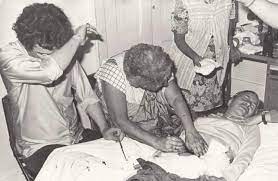The shaman who operated without anesthesia or instruments

Pachita, the shaman who miraculously performed organ transplants
Pachita claimed that she was possessed by the spirit of the tlatoani Cuauhtémoc, which allowed her to perform miracles. This is the story of "the most powerful shaman in Mexico."
Due to its strong indigenous cultural background, which moves away from excessive Western rationalism, Mexico is an attractive destination for those who like to explore the paths of esotericism and mysticism. Throughout its history, characters that border on the paranormal have appeared in our country, from presidents like Francisco I. Madero or Plutarco Elías Calles, to apocryphal saints like Niño Fidencio or Maria Sabina. Without a doubt, one of these human beings who has marked the spiritual life of the country is Pachita, a shaman who was the subject of study by the scientist Jacobo Grinberg, and whose life was immersed in mystery.
According to Grinberg, Bárbara Guerrero alias "Pachita" was born in 1900 in Parral, Chihuahua. Abandoned by her parents, Pachita was raised by an Afro-descendant named Charles, who taught her to observe the stars and heal. Later, she Pachita joined the ranks of the revolutionary Francisco Villa, where she fought. Mired in poverty, Pachita was also a cabaret performer, a lottery ticket seller and a singer on public transportation.
Pachita in one of the psychic operations. She often materialized organs out of thin air.

Without a moralistic perspective, Grinberg points out that all these experiences forged a wise character in Pachita, since she had faced harsh reality, transcending the world of illusions. Due to this spiritual depth, Ella Pachita would have developed the ability to work portents, which would make her "the most powerful shaman in the history of Mexico."
Pachita, the mystical surgeon
Pachita's fame spread in the 1970s, when characters from all social classes attended her office in the enigmatic Witch House in the Roma neighborhood. There, Pachita performed miraculous surgeries that consisted of opening the patient with an old knife, removing damaged organs and placing a new one materialized through a portent. In the end, Pachita closed the wound simply by placing her hands on it, after which there was no evidence of the surgical process.
«During the operations she performed she was capable of materializing and dematerializing objects, organs and tissues. The management of organic structures allowed him to perform organ transplants at will, cures of all kinds and remote diagnoses with colossal power and accuracy.
Grinberg mentions it in his book Pachita.
Although people were looking for her, Pachita did not attribute the healing gifts to herself, as she claimed that her body was possessed by the spirit of Cuauhtémoc, whom she called "Little Brother." According to Pachita, the tlatoani would have been the last possessor of the power to work portents, which required a body to continue helping people.
«She entered into a trance, transforming her personality and carrying out the operations that I have mentioned [...] It was Cuauhtémoc's birthday and the operation site was dressed in flowers and saturated with incense. Pachita sat in the center of the room, took a deep breath and a few minutes later, Cuauhtémoc's greeting introduced us to a magical world. In a magnificent message, the Brother communicated to us his wishes for him and his love for him.
Grinberg recounted.
Dr Jacobo Grinberg, who extensively studied the Pachita phenomenon, mysteriously disappeared. To this day, his fate is unknown.

How did Bárbara Guerrero operate?
The Pachita phenomenon attracted researchers from different disciplines, including the writer and film director, Alejandro Jodorowsky, and the former Jesuit Salvador Freixedo, who specialized in paranormal studies. There are testimonies about both characters, however Jodorowsky went further, placing himself in the hands of Pachita to undergo liver surgery. In his book The Dance of Reality: Psychomagic and Psychoshamanism, Jodorowsky relates:
“I suffered, apart from the smell of blood and the horrible sight of the maroon viscera, the greatest pain I had ever felt in my life. She squealed shamelessly. She gave the last pull. He showed me a piece of matter that seemed to move like a toad, he had it wrapped in black paper, he placed my liver in its place, he ran his hands over my belly, closing the wound, and immediately the pain disappeared. If it was sleight of hand, the illusion was perfect.”
For his part, Freixedo mentioned about his meeting with Pachita:
«I was looking at Pachita's raised hand, totally ignorant of what was going to happen. Suddenly, I saw a piece of reddish meat appear between her fingers. She didn't even look at it, she simply threw it into the large hole she had made in the sick man's lower back. She didn't even bother to put it up.
Pachita and the syntergistic theory: Everything is one
Although there were several researchers and curious people who visited Pachita, without a doubt Jacobo Grinberg was the one who searched most earnestly for an answer to the portents. For the above, Grinberg made use of his syntergic theory, which proposed that “there are no objects separate from each other but rather it is an informational field of extraordinary complexity and that our brain interacts with this field.” Without conceptual obsessions, Grinberg mentioned that this field is the same one that some physicists call the “pre-spatial field” and that when the brain interacts with the field, the spatio-temporal perception that we know (objects with shape and figure) is generated.
According to the theory, what we perceive is the final result of an interaction between the information matrix and our brain, but we do not have access to knowing how this perception was created, which is why we come to think that reality is independent of us . .
Laticce, the possibility of recreating reality
Regarding the portents of shamans, Jacobo Grinberg thought that when reality is created as a result of the cerebral process, it has reality but as consciousness and not material. Because Pachita was in a place of full consciousness, he could act from the laws of that level, in which the person breaks the illusion of his individuality and realizes that in reality everything is consciousness.
According to Grinberg's hypothesis, these highly empowered exceptional human beings would have access to the laticce, a fundamental structure that posits that space is a hypercomplex energetic network or matrix of absolute coherence and total symmetry. By having direct access to the information field through complex neurological work, shamans would be able to modify sensitive reality.
«Pachita had unique control over her neural field, transforming it and modifying the structure of the lattice. Although its effects seemed to be miraculous, they were based, according to this hypothesis, on the same mechanism that we all use to create our images or our thoughts.
Likewise, Grinberg stated that Pachita's neural field reached a state of full consciousness about the unity of existence, so her ego dissolved and returned to its origin. Once fused with full reality, she was able to act as "a king of creation," for she was undifferentiated in the laticce. In this same way, Grinberg explained Bárbara Guerrero's ability to read other people's thoughts, since her neural field allowed her to visit different places in the informational matrix.
How were Pachita and little brother Cuauhtémoc related?
Despite his own conviction, Grinberg remained skeptical about the relationship between Pachita and the spirit of the tlatoani Cuautémoc, since he thought that if there was a unity of existence, human beings must completely dissolve after death, erasing all traces of individuality. , as is personality. However, after Pachita's death, Grinberg became educated in Islamic Sufi thought, discovering that individuality in itself is already a manifestation of the Unity of Being.
«I met Pachita when I should have met her. With her I learned that individuality is preserved even after bodily death, that the feeling of being a self, independent and complete, is healthy and must expand until accessing the Whole, that unity is not achieved by destroying the ego but by transforming it later. to accept it. Her greatest gift was the understanding that one is always and that, therefore, it is necessary to respect the experience of existence and not invalidate it.
The Jewish-Mexican scientist explains in the introduction to his book Pachita.
A great ending
Pachita's portents were widely documented in the books of Jacobo Grinberg. According to the testimonies collected in the documentary The Secret of Doctor Grinberg, Pachita and the scientist separated to prevent the relationship between the shaman and the family of President Luis Echeverría from becoming public. Bárbara Guerrero died in Mexico City, on April 29, 1979.
The mystery of Pachita
Audiobook THE PSYCOMAGIA OF PACHITA, by Jodorowsky




